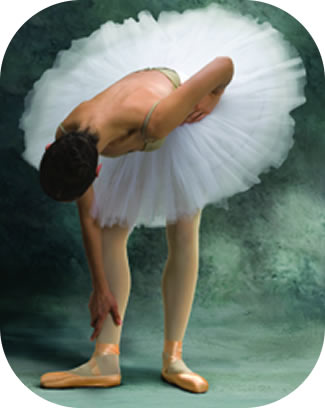Shin Pain
 If a dancer’s training, rehearsal, or performance involve a lot of jumping (i.e. ballet and other cultural dances) and is combined with improper technique and/or overuse, this can easily lead to a strain of the posterior tibial muscle. There's really no way to deter this if jumping is a regular routine in a dancer’s field, however paying attention to technique will do wonders for you. A dancer should remember proper landing techniques and the concept of “sinking” the heel. Shin splints can turn into stress fractures if a dancer continues to “dance through the pain.” Other factors for shin splints can include anorexia nervosa or amenorrhea. At night some dancers deal with shin pain with topical relief lotions and products designed to deal with strain and inflammation. Products containing aloe vera, arnica and chondroitin are causing a positive stir in the dancer community and seem to be steadily providing results. These products, combined with apt rest in between training, appear to be the recommended remedy. Footwork may also lead to shin problems if there are imbalances. For example, when a dancer balances on their feet, this footwork hardly ever involves the “inverted position” (primarily in ballet) “but instead creates a ‘winged’ (abducted, non-weight bearing) type position, which results in constant stretching of the tendon. Since shin pain is largely due to technique and overuse, it’s wise to look at some basic reminders. Malkogeorgos et al, states that there are 5 “areas of attention for preventing dance injuries” so keep these in mind when actively preventing shin pain. They include: warm-up, training (muscle strength, power, endurance, agility, dance-specific technique), equipment (footwear and floor surfaces), the rules and regulations governing dance, and self-care prevention and treatment.
If a dancer’s training, rehearsal, or performance involve a lot of jumping (i.e. ballet and other cultural dances) and is combined with improper technique and/or overuse, this can easily lead to a strain of the posterior tibial muscle. There's really no way to deter this if jumping is a regular routine in a dancer’s field, however paying attention to technique will do wonders for you. A dancer should remember proper landing techniques and the concept of “sinking” the heel. Shin splints can turn into stress fractures if a dancer continues to “dance through the pain.” Other factors for shin splints can include anorexia nervosa or amenorrhea. At night some dancers deal with shin pain with topical relief lotions and products designed to deal with strain and inflammation. Products containing aloe vera, arnica and chondroitin are causing a positive stir in the dancer community and seem to be steadily providing results. These products, combined with apt rest in between training, appear to be the recommended remedy. Footwork may also lead to shin problems if there are imbalances. For example, when a dancer balances on their feet, this footwork hardly ever involves the “inverted position” (primarily in ballet) “but instead creates a ‘winged’ (abducted, non-weight bearing) type position, which results in constant stretching of the tendon. Since shin pain is largely due to technique and overuse, it’s wise to look at some basic reminders. Malkogeorgos et al, states that there are 5 “areas of attention for preventing dance injuries” so keep these in mind when actively preventing shin pain. They include: warm-up, training (muscle strength, power, endurance, agility, dance-specific technique), equipment (footwear and floor surfaces), the rules and regulations governing dance, and self-care prevention and treatment.

